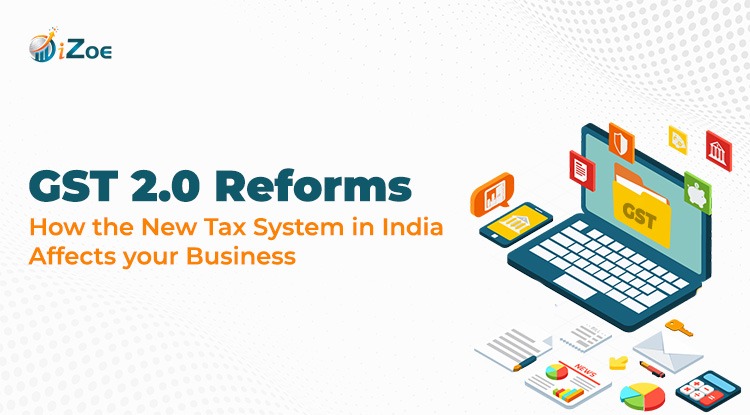India is moving into a new phase of indirect taxation. The latest overhaul of the Goods and Services Tax was approved by the GST Council on 3rd September 2025, at its 56 th meeting since its introduction. Popularly known as GST 2.0, this revision streamlines tax rates, lowers compliance headaches, and creates a relief to both businesses and consumers.
The new rates will take effect on 22nd September 2025, just before the festive season a measure to enhance domestic consumption and also to ensure India is economically resilient.
What’s Changing in GST 2.0?
The previous four-level system of 5%, 12%, 18 and 28 has been changed to a less complex system:
5 percent (Merit Rate): goods of necessity and mass consumption.
18 percent (Standard Rate): The majority of other goods and services.
40% (Special Rate): Choose luxury and sin products such as aerated beverages, premium vehicles, cigarettes, casinos and Indoor Premier League tickets.
This rationalisation will serve to:
Minimize compliance complexity.
Reduce consumer tax payments.
Solve inverted duty structures.
Increase expenditure and corporate competitiveness.
Pad the economy against increasing world uncertainty and American tariffs on Indian exports.
What Gets Cheaper?
The reforms introduce a visible decrease in daily costs and company expenses:
1. Food & Beverages: Chapati, paneer, UHT milk, and parathas will be categorized as 0% GST and butter, ghee, biscuits, juices, and ice creams will change to 5% taxation as compared to 18%.
2. Household Items: Soaps, shampoos, toothpaste, hair oil, utensils, bicycles and umbrellas will receive only 5% GST as compared to 12-18.
3. Electronics and Appliances: Televisions, ACs, and dishwashers decrease by 28 percent to 18 percent, making the ownership affordable.
4. Stationery and Education: Notebooks, pencils, maps and charts are GST free now and, as a result of this, the learning materials are affordable.
5. Healthcare: Life-saving drugs, medical test kits, thermometers and corrective eye wear transfer to 0-5, which minimizes healthcare costs.
6. Travel & Hospitality: Hotel accommodations to a limit of 7,500 and economy class airfares will be taxed (5% as opposed to 12%).
7. Agriculture: Farm machinery, fertilisers, and tractors reduce to 5% and cost goes down to the farmers.
8. Textiles & Footwear: The mass-market products shift 12% to 5% improving the competitiveness of the industry.
What Gets Costlier?
All is not cheaper in GST 2.0. The government has added a special rate of 40 percent on:
Caffeinated beverages and aerated drinks.
- Large cars and luxury bikes
- Yachts, race cars and personal planes.
- Tobacco products (post-cess period)
- Casinos, web based gambling and IPL tickets.
- This makes the essentials cheaper and the luxury and sin goods highly taxed.
Lessons to the Businesses.
The GST 2.0 does not only entail reduction of rate but simplifying of the system to ease operations.
- Textiles and FMCG: Reduced rates create free working capital and increase exports.
- Agriculture & Fertilisers: Due to the reduction in the cost of inputs, the margins will be stronger and farmers will be able to afford to farm.
- Education: Stationery tax is zero and benefits the families by providing positive social value.
- Healthcare: Reduced GST will decrease the prices of patients, thus making it more affordable.
- Hospitality & Travel: Domestic tourism would be stimulated by cheaper air tickets and hotels.
Three Pillars of GST 2.0 Reforms:
Structural remedies: Duty inversion structures and classification controversies eliminated.
Rate Rationalisation: Low taxes to mass consumption goods, business stability.
Convenience of compliance: Auto-filled returns, expedited refunds and simplified registration.
This Implications on TallyPrime
Those who are already using TallyPrime to bill and comply with GST have a good news:
Instant Updates: Before 22 nd September, new GST rates will automatically be updated in TallyPrime.
Error-Free Filing: Computerized reconciliation and reporting ensure that your compliance is correct.
Fewer Stops and Forward: Returns and ITC corrections are already GST 2.0 compatible.
The Road Ahead
GST 2.0 is not just a tax reform, but it is a move towards a business-friendly environment that is simpler and fair. The government has helped to establish the environment in which domestic growth will boost its growth as it has relieved the pressure placed on compliance and made basic necessities cheaper.
To businesses, it is time to remain active, modernize, educate the teams, and enjoy the better cash flows and lower tax bills.
Conclusion:
GST 2.0 is more than a tax rate adjustment, it’s a step toward making compliance simpler and business operations smoother. For companies, this means an opportunity to streamline processes, reduce costs, and focus on growth instead of paperwork. But adapting quickly is the key to gaining these advantages.
This is where iZoe can help—with cloud-ready Tally solutions, automated updates, and reliable compliance tools, iZoe ensures your business stays GST 2.0 ready without the stress. By combining technology with expertise, iZoe makes the transition effortless so you can stay compliant, competitive, and ahead of the curve.
About The Author
iZoe
iZoe Solutions offers cloud, automation, ERP, and analytics solutions designed to help businesses grow faster and work smarter. Our blog shares expert insights to guide companies through digital transformation, financial automation, and modern IT upgrades.

